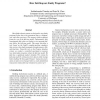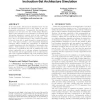994 search results - page 57 / 199 » Simulation Model of the Telemedicine Program |
FTCS
1998
14 years 11 months ago
1998
Most fault-tolerant systems are designed to stop faulty programs before they write permanent data or communicate with other processes. This property (halt-on-failure) forms the co...
AVI
2004
14 years 11 months ago
2004
We present a program visualization tool called Jeliot 3 that is designed to aid novice students to learn procedural and object oriented programming. The key feature of Jeliot is t...
DAC
2002
ACM
15 years 10 months ago
2002
ACM
In the last decade, instruction-set simulators have become an essential development tool for the design of new programmable architectures. Consequently, the simulator performance ...
CODES
2006
IEEE
15 years 3 months ago
2006
IEEE
Traditionally, instruction-set simulators (ISS’s) are sequential programs running on individual processors. Besides the advances of simulation techniques, ISS’s have been main...
WSC
2001
14 years 11 months ago
2001
We review chessboard distributions for modeling partially specified finite-dimensional random vectors. Chessboard distributions can match a given set of marginals, a given covaria...


